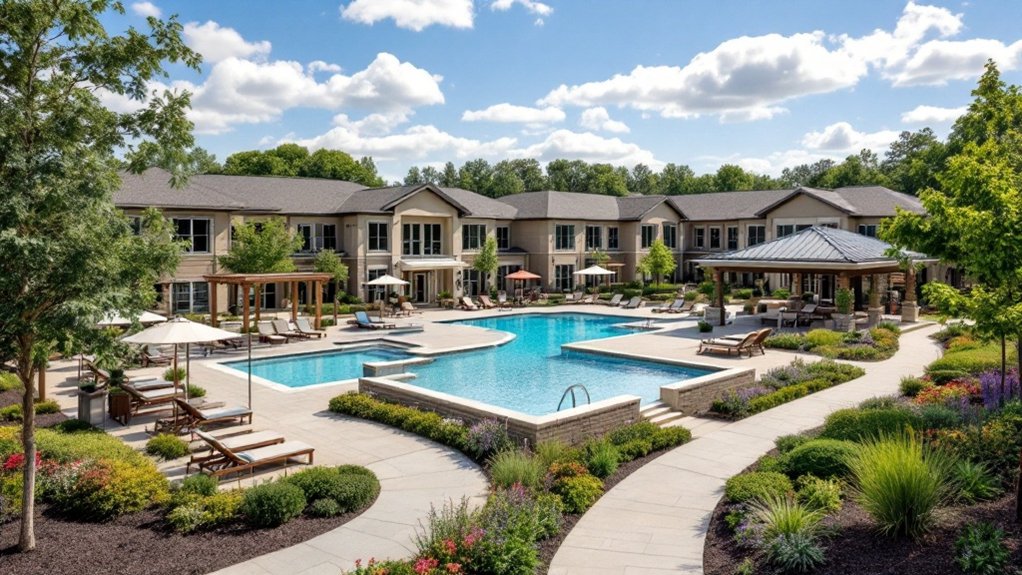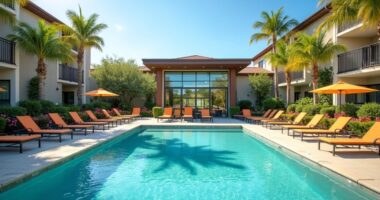Independent living communities provide adults 55+ with maintenance-free residences combining private housing and extensive amenities. You'll find diverse accommodation options including apartments, condos, and single-family homes equipped with adaptive features like wider doorways and strategic grab bars. These age-restricted environments offer 24-hour security, organized activities, fitness facilities, and educational programs while fostering resident participation in community governance. Further exploration reveals how these communities deliver thorough lifestyle benefits through their financial structures and social frameworks.

While traditional retirement options often limit seniors to basic residential arrangements, independent living communities have emerged as all-encompassing lifestyle solutions that combine private accommodations with extensive amenities and social engagement opportunities.
Modern independent living communities transcend basic senior housing, offering complete lifestyle experiences with private spaces and rich social connections.
You'll find diverse housing configurations, from apartments and condominiums to single-family homes, all designed to accommodate active seniors seeking liberation from routine home maintenance while retaining their independence. These communities integrate adaptive architectural features, such as wider doorways and strategic grab bar placement, ensuring ideal accessibility without compromising aesthetic appeal. Age-restricted communities provide an environment specifically tailored to individuals 55 and older. Communities offer 24-hour security with surveillance systems and well-lit grounds to ensure resident safety.
The financial framework typically encompasses both entrance fees, which may be partially or fully refundable upon departure, and monthly service fees covering thorough maintenance, housekeeping, and amenity access.
You'll discover that despite initial investment requirements, the consolidated cost structure often proves more economical than maintaining a traditional residence, particularly when factoring in routine maintenance, utilities, and property taxes. Life Plan Communities, while commanding higher entrance fees, provide the additional security of guaranteed access to higher levels of care should your needs evolve. Resident testimonials consistently highlight the financial benefits and peace of mind these communities provide.
Your lifestyle within these communities centers on an extensive array of programmed activities and amenities designed to promote physical, intellectual, and social well-being.
You'll have access to fitness facilities offering specialized senior-focused programs, including adaptive sports, tai chi, and strength training regimens. The communities facilitate continuous learning through partnerships with educational institutions, providing lectures, workshops, and seminars that keep residents intellectually engaged.
The social infrastructure encompasses organized events, ranging from wine tastings to cultural excursions, fostering robust community engagement.
You'll find yourself part of a dynamic environment where residents often participate in community governance, contributing to administrative decisions that shape the community's direction.
The combination of private residences proximate to shared amenities creates an environment that promotes both independence and interconnectedness, allowing you to maintain an active, maintenance-free lifestyle while building meaningful social connections within a supportive community framework.
Frequently Asked Questions
Can I Bring My Own Furniture to an Independent Living Community?
You can bring your own furniture to independent living communities, as they provide spacious apartments designed to accommodate personal belongings.
While facilities may maintain specific guidelines regarding size restrictions or safety requirements, you'll have significant flexibility in personalizing your living space.
You'll need to take into account apartment dimensions when planning furniture placement, and many communities offer assistance with layout optimization to guarantee comfort and functionality.
What Happens if My Health Needs Change While Living There?
If your health needs change, you'll need to evaluate shifting to a higher level of care, either within the same community or at a different facility.
Many independent living communities offer multiple care levels on one campus, allowing for seamless shifts to assisted living or skilled nursing.
You'll work with staff to assess your needs, modify your care plan, and determine appropriate accommodations while considering the financial implications of increased care requirements.
Are Pets Allowed in Independent Living Communities?
Most independent living communities allow pets, though you'll encounter specific policies regarding size, breed, and quantity restrictions.
You'll typically find communities permitting small to medium-sized dogs under 45 pounds and domesticated cats, with a standard limit of 1-2 pets per residence.
You'll need to verify vaccination requirements and expect to pay pet deposits or monthly fees, which average $200-500 initially plus $25-50 monthly.
How Often Can Family Members Visit and Stay Overnight?
Visitation policies vary across independent living communities, but you'll typically find daily visiting hours between 8 AM and 8 PM, requiring visitor sign-in.
While overnight stays generally need advance approval, communities with guest accommodations may permit 2-3 consecutive nights.
Your frequency of visits depends on the facility's capacity, with larger communities often allowing more flexible arrangements than smaller ones, subject to health protocols and community guidelines.
Can I Maintain My Own Garden or Outdoor Space?
You'll typically find extensive opportunities to maintain your own garden space in independent living communities, with 87% of facilities offering designated gardening areas.
Most communities provide both personal plot options and raised beds to accommodate mobility needs, while offering supplemental maintenance assistance if required.
You can cultivate flowers, vegetables, and herbs in your allocated space, though you'll need to adhere to the community's landscaping guidelines.









